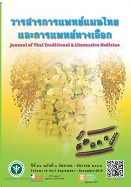Comparison of Chemical Compositions, Nutritional Values, Antioxidant and Tyrosinase Inhibition Activities in Corn Silk of Three Different Corn Varieties
Main Article Content
Abstract
Corn silk rubble left over from the privatization process in the industry with a lot of corn. The study was conducted to compare three different varieties of corn silk; Sweet L. var. corn ( Zea mays L. var. saccharata), Sweet corn (Zea mays saccharata), Waxy corn (Zea mays ceratina) in chemical compositions, nutritional values, antioxidant and tyrosinase inhibition activity. The three varieties of crude corn silk extracts chemical elements were tested by Thin layer chromatography assay. The results shown that 50% ethanolic extract of corn silk found phenolic compound and flavonoids. Proximate analysis revealed that sweet corn silk with moisture content, the highest percentage, 10.26 ± 0.66 from waxy corn silk with ash, the highest percentage, 6.43 ± 1.77 from sweet corn silk has a fat content, the highest percentage, 0.29 ± 0.17 from waxy corn silk fiber the highest percentage, 14.13 ± 0.44 from sweet corn silk protein, the highest percentage, 21.19 ± 0.61 and from sweet L. var. corn silk to the amount of carbohydrates, the highest percentage, 61.59 ± 1.06 For antioxidant activity with DPPH radical scavenging activity shown that the extract from sweet corn silk with IC50 value was 5991.98 ± 60.61 µg/ml. The tyrosine inhibition activity of corn silk, which can inhibit the enzyme tyrosinase, the best extracted from waxy corn silk with IC50 values were 3082.28 ± 347.98 µg/ml. The results of this study were to analyze the nutritional value and biological activity, which can be used as a basis for the development of health care products and to develop into a cosmetic product that can be used for skin whitening.
Article Details
References
2. El-Ghorab A, El-Massry KF, Shibamoto T. Chemical composition of the volatile extract and antioxidant activities of the volatile and nonvolatile extracts of Egyptian corn silk (Zea mays L.). Journal Agric Food Chem. 2007;55(22):9124–7.
3. Hu QL, Zhang LJ, Li YN, Ding YJ, Li FL. Purification and antifatigue activity of flavonoids from corn silk. International Journal of Physical Sciences. 2010;5(4):321-6.
4. Ebrahimzadeh MA, Pourmorad F, Hafezi S. Antioxidant activities of Iranian corn silk. Turkish Journal of Biology. 2008;32:43–9.
5. Velazquez DVO, Xavier HS, Batista JEM, de Castro-Chaves C. Zea mays L. extracts modify glomerular function and potassium urinary excretion in conscious rats. Phytomedicine. 2005;12(5):363–9.
6. Wadbua P, Siri S, Kitancharoen N, Wongphathanakul W. The use of crude extract of Punica Granatum Linn pericarp to inhibit Catfish pathogenic bacteria. KKU research Journal. 2007;7(1):27-35. (in Thai)
7. AOAC. Official Methods of Analysis of AOAC International. USA: Maryland; 2000.
8. Mongkolsilp S, Pongbupakit P, Sae-Lee N, Sitthithaworn W. Radical scavenging activity and total phenolic content of medicinal plants used in primary health care. SWU Journal of Pharmaceutical Science. 2004;9:32-5. (in Thai)
9. Phuapaiboon P. Studies on the antioxidant content of wines produced from bark and fruit core. Mahasarakram university. Research and Development Institute. 2006. (in Thai)
10. Chan EWC, Lim YY, Wong LF, Lianto FS, Wong SK, Lim KK, et al. Antioxidant and tyrosinase inhibition properties of leaves and rhizomes of ginger species. Food Chemistry. 2008;109(3):477–83.
11. Rosli W, Nurhanan WI, Mohsin AR, Farid SSJ, Ghazali C. Aqueous, alcoholic treated and proximate analysis of Maydis stigma (Zea mays hairs). Annals of microscopy. 2008;8:66–72.
12. Liu J, Wang C, Wang Z, Zhang C, Lu S, Liu J. The antioxidant and free radical scavenging activities of extract and fractions from corn silk (Zea mays L.) and related flavone glycosides. Food Chemistry. 2011;126(1):261–9.
13. Thoudam B, Kirithika T, Ramya J, Usha K. Phytochemical constituents and antioxidant activity of various extracts of corn silk (Zea mays. L). Research Journal of Pharmaceutical, Biological and Chemical Sciences. 2011;2(4):986–93.

